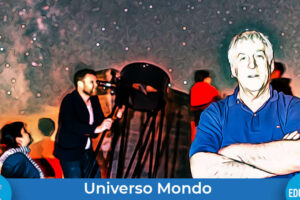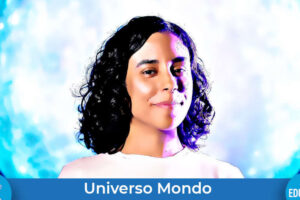Aggiornato il 17 Febbraio 2025
Welcome back to a new column of Universe World! This week we travel to Japan, where we meet Professor Hidehiko Agata, astronomer, prolific author, science education and science communication specialist, who has been sharing the excitement of the Universe with Japanese and international audiences for over 25 years.

Tell us about yourself and your job…
My job is to promote astronomy: “Science to Culture!” and “Astronomy for All!” are my slogans. I have been working at the National Astronomical Observatory of Japan (NAOJ) for 25 years. There are less than 170 researchers at NAOJ. Almost all are astronomers and only a few are engineering PhDs.
As the only science education and science communication specialist among them, I am an associate professor at NAOJ. I was the first Education & Public Outreach (EPO) activity researcher among Japanese basic science laboratories.
Those are great slogans! What inspired you towards this path?
I studied astronomy up to my master’s degree. I have been an astronomy boy since childhood. I did comet research when I was young. Meanwhile, I was a science teacher at junior and senior high schools for 14 years before I started working at NAOJ.
I did not get my doctorate in education until I started working at NAOJ, when I was 42 years old. Even now, the many experiences I had while teaching are still a part of my life.
In 1999, NAOJ constructed the Subaru Telescope with an 8.2-meter aperture on Mauna Kea, Hawaii. I was hired as a specialist to disseminate its achievements to the world, as I had published many books on astronomy at the time.
Indeed, you have published quite a number of books. How many?
To date, I have published over 130 books. Some have been translated into Korean and Chinese, but most are in Japanese.
Wow, that is lot! Any plans for the future?
I hope to publish 200 books in my lifetime. This is my life’s work. I would very much like to publish English translations of my books so that they can be read not only in Japan, Taiwan, China, and Korea, but also by people all over the world.

Being at the forefront of astronomy communication and education for so many years, would you say that the field has changed over time, and if so, how?
During the past quarter century, astronomy has changed dramatically from “geek culture” to something closer to mainstream culture. For example, in Japanese junior high schools and high schools, astronomy clubs were very minor extracurricular activities during the 20th century, with only a very small number of students joining. It was about the same as railroad research clubs or calligraphy clubs.
However, after the Leonid meteor shower scare around 1999-2002 [an extraordinarily intense meteor shower], the number of club members increased, and astronomy boys and girls were no longer looked at strangely by the public. The beginning of the 21st century was a time when not only the Leonid meteor shower, but also eclipses, comets, and other astronomical phenomena and events attracted much attention, but not only that.
In Japan, the latest news in astronomy and space science, such as the achievements of the Subaru Telescope and the success of the asteroid probes Hayabusa and Hayabusa2, attracted people’s attention. Internationally, many other exciting discoveries have increased people’s interest in the universe.
How did Japanese astronomy institutions react to this new spur of interest?
It is important to note that science communication in the field of astronomy, including PR activities and outreach, has been much more active than in other fields of academic research, and this has led to positive results.
In the past 25 years, NAOJ had only myself and a few part-time staff members for PR and outreach, but now we have EPO staff members for all projects. 25 years ago, NAOJ’s budget allocated to EPO was about 0.6% of the total budget, but now it is probably more than 2%. However, I think even this is too small, and above all, it is essential to make efforts to improve the employment conditions of EPO staff. Unfortunately, they are still often more disadvantaged than researchers and technicians. I would like to improve this.
What do you think are the biggest challenges for astronomy and science communication today?
For astronomy, I believe that the most important communication challenge is to encourage everyone on the planet (especially those in power) to understand the Pale Blue Dot message.
The challenge for science communication as a whole will be to adapt to the “unpredictable, uncertain, complex, and ambiguous times” of the near future and achieve wellbeing for individuals and society./p>

If you met a young aspiring science communicator who wishes to enter the field today, what would be your professional advice?
For many people working as science communicators around the world today, their jobs may not necessarily be stable for life. It is a precarious profession where fixed-term work and piece-rate compensation are the norm.
Nevertheless, there are few other contributions to society that are as rewarding. Therefore, I would like you to establish your own unshakable position. Don’t be a frivolous science communicator whose previous arguments are overturned when your position changes. I would also like you to increase your tolerance and metacognition. I am sure that there will be times when you lament your inability or find communication troublesome. But it is the same experience for all of us. With faith and without neglecting your studies, let’s do our best to make this society a better place.

What are the most exciting and most difficult parts in your job?
What pleases me most is when I am approached by people I do not know, especially when I go to international conferences. As a result, for example, I was able to collaborate with a respected researcher, Wanda Diaz-Merced. She stayed at NAOJ for six months.
Tips and opportunities for outreach and science communication lie in many places. Very little can be done alone, and most of it is collaborative research and joint projects. So, I am most happy to have met many good and reliable friends.
On the other hand, science communication, as an academic research, is unfortunately still looked down upon by astronomy and other fields. The most difficult obstacle for me is to improve this situation and realize that young people can feel comfortable working in the field of science communication.
From your extensive experience, what’s the project you are most proud of, and why?
There are three. First, visitor services and regional cooperation. We started in 2000 to open NAOJ’s Mitaka Headquarters to the public at all times, in other words, to provide visitor services. The first thing I did when I started working at NAOJ was to establish a tour course, with basically all campuses and observatories offering visitor services. We try to cooperate and collaborate not only with the Mitaka Head Office but also with the local government in all of our observatories as well as with the facilities open to the public.
Second, the 4D2U (4-Dimensional Digital Universe) project. I have been working on the four pillars of “people”, “images”, “education” and “interdisciplinary exchange” to make astronomy grow bigger and bigger as a trunk of scientific culture. First was public relations (people) with a visible face. The next challenge was “images”. In 2000, I participated in NAOJ’s 4D2U project and I succeeded in obtaining a large competitive grant and completed the world’s first permanent stereoscopic dome, the 4D2U Dome Theater, in 2007. We organized the International Festival of Scientific Visialisation and made efforts to train human resources (creators and producers) in the field of scientific imaging.
Third, the activities at the International Astronomical Union’s (IAU) Office for Astronomy Outreach (OAO). In 2012, OAO was established at NAOJ as one of the special offices of the IAU. I have served as the OAO Office Director and OAO Supervisor for 10 years since 2014. In parallel, I have been working on the “You are Galileo!” workshops which including telescope crafting and astronomical observation. We have been doing these workshops around the world, specially in Asian countries.
And one of my most memorable international relations activities was the success of CAP 2018, the Communicating Astronomy With the Public conference in Fukuoka in March 2018, the largest astronomy science communication conference in history with over 400 participants. At that time, I was the chairperson of the executive committee.

How is astronomy research organised in Japan? Has that changed a lot over your career?
When I was a child, that is, half a century ago, the universities where astronomy could be studied were limited to the University of Tokyo, Kyoto University, and Tohoku University. Today, astronomy courses are available at more than 100 universities in Japan. The number of foreign graduate students is also increasing.
In the past 50 years, astronomy research has grown from a minor role to one of the mainstays in Japan. Even though the budget and the number of postings have increased significantly over the past half century, it has never been enough. In particular, since the 1990s, when the Japanese economy collapsed in a bubble, it has been called the “lost 30 years” and has remained flat for the past 20 years or so because of the government’s policy of extreme reduction of spending on academia. As a result, Japan’s science and technology in general has fallen far from its second place behind the U.S. in terms of the number of papers, major publications, and patents granted, and its international contribution is currently decreasing.
However, among these, astronomy is a field that is being considered, partly due to the success of Subaru and ALMA. This is due to a high level of public interest and support, so it is safe to assume that public relations and outreach are having an effect.
You are also very much involved in the IAU’s activities of public outreach around the world. Do you see any major differences between communicating astronomy in Japan and on the global scene?
A major difference unfortunately exists. Since the International Year of Astronomy (IYA) 2009, the IAU has set forth a clear vision for the role of the IAU and the astronomical community in its strategic plans (2010-2020 and 2020-2030).
Of course, not all IAU member countries have adopted and put this philosophy into practice. I think that the Japanese astronomical community is still too focused on itself, and is not aware of the social responsibilities that researchers should fulfill. I would like to expand the philosophy of astronomy for peace, astronomy for development and astronomy for education in Japan.
Is it difficult, in your opinion, to set up such international collaborations, among very different countries and cultures, to communicate something bigger than all of us, like astronomy?
We, EPO officials in East Asia, look to the European Southern Observatory and other European initiatives as references and goals. This may be possible because European countries have a magnificent history and culture, but collaboration across countries and languages is not an easy task. Fortunately, the IAU and many other international societies and cooperative research organizations exist in astronomy, and the level of their activities is high. Asian countries also need to build a community beyond the barriers of language, culture, and customs.
Ultimately, it is extremely important to succeed in international cooperative relations and international understanding as a borderless spaceship Earth, starting with astronomy as one of the basic sciences.
Why is that important?
It is a small step, but it will connect every person on earth with people from as many countries as possible and make sure that they have friends all over the world. No one would want to start a war in the country where his or her immediate family or best friend lives. I think astronomy is an effective tool in building relationships between people that do not lead to wars, terrorism, and other such conflicts ““ as I feel from my experience.

What are you and your team working on right now?
We are working on three main things: revising the Japanese Courses of Study so that all students can learn astronomy; enabling children around the world to obtain an astronomical telescope and observe the universe; promoting astrotourism and other astronomical culture for the wellbeing of individuals and society./p>
Any experience from the past that you would do in a different way, if you had to work on it today?
I have appeared on many television and radio programs to promote astronomy and science. I still appear on a monthly radio program and several TV programs per year.
However, I think now that these were all domestic outreach. Now that we are in the age of internationalization, I would like to utilize YouTube and other media to provide content that can be enjoyed by people overseas.
Many thanks for sharing your insightful thoughts with our readers. Before closing, are there authors, books, people or special events that have especially influenced you along your journey?
Many things come to mind. Here is just one of them: the opening ceremony of the IYA 2009 took place in Paris in January 2009. I met Pedro Russo and Lars Lindberg Christensen, two of the key figures of IYA 2009, before dawn that day at the ceremony site. I am very grateful to have met them and become friends with them. I am grateful for the support they have given me since then, which has kept me going. I have learned from, inspired by, and interacted with many other people. I am very happy to have this job.





Add Comment